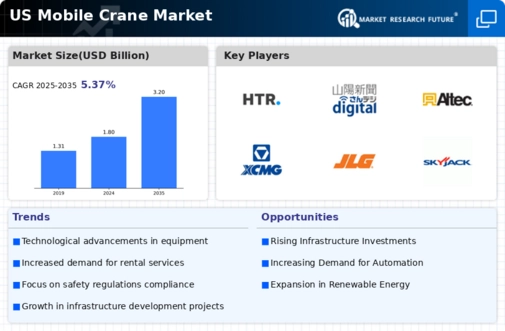Increased Construction Activities
The mobile crane market is experiencing a surge in demand due to increased construction activities across various sectors. The residential and commercial construction sectors are particularly active, with the U.S. Census Bureau reporting a 10% rise in construction spending in 2025 compared to the previous year. This uptick in construction projects necessitates the use of mobile cranes for lifting and transporting heavy materials. Additionally, the trend towards high-rise buildings and complex structures further emphasizes the need for advanced lifting solutions. As construction companies seek to enhance efficiency and safety, the mobile crane market is likely to benefit from this growing demand, positioning itself as an essential component of the construction landscape.
Expansion of Renewable Energy Projects
The mobile crane market is benefiting from the expansion of renewable energy projects across the United States. As the country shifts towards sustainable energy sources, significant investments are being made in wind, solar, and other renewable energy infrastructures. The U.S. Department of Energy has reported a projected investment of over $50 billion in renewable energy projects by 2026. This surge in renewable energy initiatives necessitates the use of mobile cranes for the installation and maintenance of large-scale energy systems. As such, the mobile crane market is likely to see increased demand driven by the need for efficient lifting solutions in the renewable energy sector.
Infrastructure Development Initiatives
The mobile crane market is poised for growth due to ongoing infrastructure development initiatives across the United States. Government investments in transportation, bridges, and public facilities are expected to drive demand for mobile cranes. For instance, the Federal Highway Administration has allocated approximately $15 billion for infrastructure projects in 2025, which will likely necessitate the use of mobile cranes for construction and maintenance. This trend indicates a robust pipeline of projects that will require heavy lifting equipment, thereby enhancing the mobile crane market. Furthermore, as urbanization continues, the need for efficient construction solutions becomes paramount, suggesting that mobile cranes will play a critical role in meeting these demands.
Technological Integration in Equipment
The mobile crane market is witnessing a transformation through the integration of advanced technologies in equipment. Innovations such as telematics, automation, and enhanced safety features are becoming increasingly prevalent. These technologies not only improve operational efficiency but also enhance safety standards, which is crucial in the construction industry. For example, the incorporation of real-time data analytics allows operators to monitor crane performance and optimize usage, potentially reducing operational costs by up to 15%. As construction firms prioritize safety and efficiency, the demand for technologically advanced mobile cranes is expected to rise, indicating a positive outlook for the mobile crane market.
Regulatory Compliance and Safety Standards
The mobile crane market is significantly influenced by regulatory compliance and safety standards imposed by federal and state agencies. The Occupational Safety and Health Administration (OSHA) has established stringent guidelines for crane operations, which necessitate the use of compliant equipment. As companies strive to adhere to these regulations, the demand for modern, safe mobile cranes is likely to increase. This trend not only ensures worker safety but also enhances operational efficiency, as compliant cranes often come equipped with advanced safety features. Consequently, the mobile crane market may experience growth as businesses invest in equipment that meets or exceeds regulatory requirements.























Leave a Comment